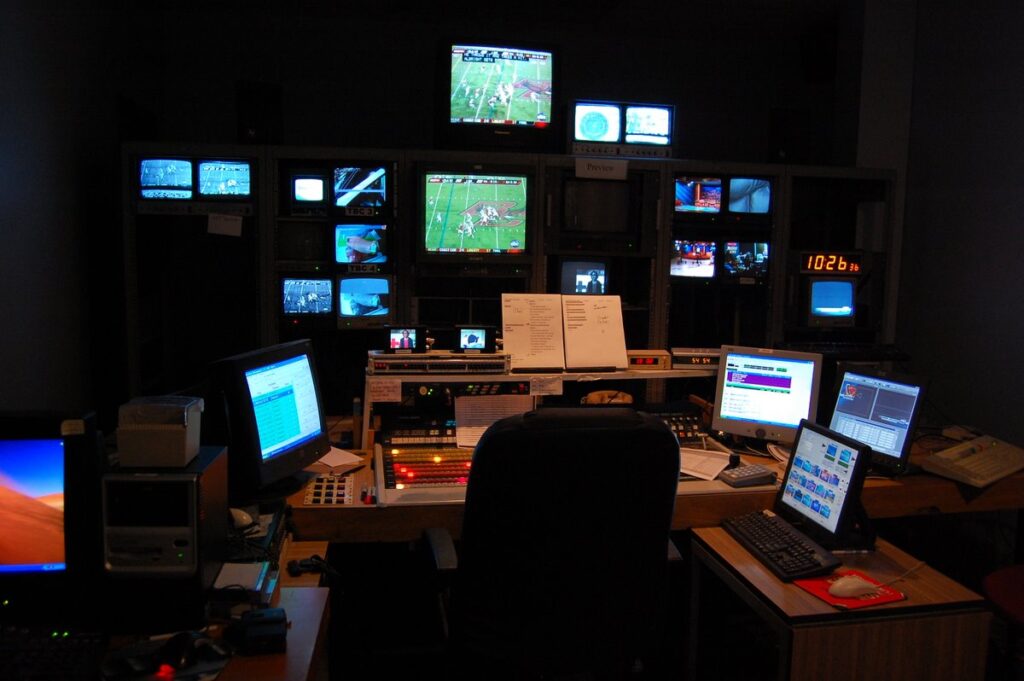
Live or up-to-the-minute coverage of news events is expensive for TV stations, but also essential in today’s fast-paced world of viral videos and many big stories breaking on Twitter.
TV needs to offer high-quality video from the scene of a breaking news event to grab and hold the attention of easily-distracted viewers. However, production costs and quality issues are a constant problem.
Is Remote Production Technology Right for You?
Right now, many broadcasters are wondering if a dark fiber or IP circuit connection can help cut down on costs. These connections allow the transmission of multiple signals, including large amounts of unprocessed HD video, in a quick and efficient manner. Equipment is small and portable—no bulky, hard to maneuver, gas-guzzling live truck required. Often only the reporter and one photographer are needed to cover a big event (similar to the number of personnel needed to cover one story that isn’t for live broadcast). Stations can simultaneously cover as many events as they have reporters.
Up-Front Costs Vs.Long-Term Costs
Dark fiber and IP circuits can be expensive. Dark fiber is usually obtained through a local telecom company—Verizon, AT&T, and CenturyLink are the current leaders in the field. In some areas, there are also independent companies in the growing market for dark fiber (which appeals to a wide variety of business clients, not just those in the broadcast industry).
If you have more than one provider in your area, compare prices. Be sure to ask about maintenance costs, who foots the bill if a cable is damaged, and what the company’s track record is with installation or end-user problems.
If dark fiber is not an option in your area, consider IP circuits. These are booked by bandwidth, so your station can use them for multiple things: sending video, sharing a network connection, and so on. Video and audio are sent back to the broadcaster’s home base quickly and easily, with no need for a huge satellite truck and staff.
Both options can be expensive up-front, and the reality may be that your station simply can’t afford it right now, but it may be something you consider in the next few years.
Keep in mind that while your equipment cost may be high initially, and there are some maintenance costs involved with any technology, dark fiber and IP circuits may be cheaper to maintain than a satellite truck, depending on your current costs.
These technologies prevent high fuel costs, time wasted struggling to maneuver a large vehicle into an appropriate parking place (or three) while news is happening, the potential for accidents/liabilities, and the need for multiple employees to run to one news scene. In the long run, remote production will usually save the station money.
An Alternative to a New Live Truck
If your station is considering adding a new live truck or replacing an old one, you might consider investing in dark fiber or IP circuits instead.
A recent Business Insider article reports that connecting a “large client” with dark fiber can cost anywhere from $50,000-150,000. However, dark fiber have clients in many fields, including businesses that are larger than most local television stations.
Depending on your needs, the acquisition of a dark fiber link could be about the same as what you’d spend on a live truck. Depending on a variety of factors, live trucks can cost anywhere from $90,000 on the low end to half a million dollars on the high end.
Additional Benefits
Aside from saving money, the station can produce better packages. Editing in a tiny truck with limited equipment prior to—or in between—live shots is not ideal. Back at the station, if a piece of equipment breaks, there are usually multiple spares you can use instead. If you don’t know how to solve a problem, there is often a colleague available to help. Out in the field, this isn’t usually the case.
Additionally, sometimes reporters, photographers, and other staff are distracted by difficulties at the scene (“You better move this truck right now or you’re getting a ticket!”) or further breaking news. Sending video back to the station for editing allows for a much higher quality ending product, often in less time.
Preventing Miscommunication
One concern is that colleagues back at the station might misunderstand some point the journalist was trying to make in his or her story since they are not on the scene, experiencing things for themselves. To prevent misunderstandings, make sure to send instructions along with your script. Try to describe the atmosphere of the scene. Adding some notes can help the editors back at the station, who may not have captured the essence of the breaking news or event in quite the same way you did. A quick phone call can help clear up any misunderstandings.
If it turns out that, despite your best efforts, a colleague back at the station didn’t understand something, and the video isn’t quite matching what you’re talking about, try to roll with it. Make some effort to refer to the cover video that’s playing or contents of the package that just ran, and get back on track as smoothly as you can.
Not the Best Solution for Extremely Large Events
Once you have more than 25 camera feeds, broadband costs start to rival those of booking time on a satellite. There’s also the increased possibility of technical difficulties jamming up the whole operation.
For such an extremely large event, you will probably want to use a live truck, at least in addition to remote production technologies. However, most small and medium market stations will rarely, if ever, find themselves in such a situation.
Most of the time, remote production will save the station time and money, and allow for a higher quality level of production.
[su_note]Learn more about the School of Broadcast Journalism at the New York Film Academy by clicking here.[/su_note]